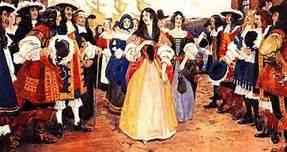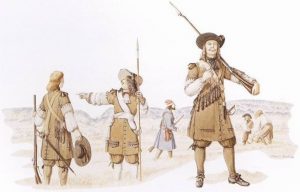Prior to 1663, the majority of women who arrived in Canada were married to one of the settlers or were single women who came looking for a husband. These single women were few in number and often paid there own passage to Canada by a contract of indenture. In 1663, when King Louis XIV became concerned with populating the colony, he directed recruitment of women to be sent to Canada.
Once chosen, the girl was given passage, in addition to clothing and personal necessities. She was also given a dowry of 59 Livres if she married a soldier or habitant or 100 livres if she married an officer.
Of the nearly 1,000 women who undertook the journey, about 800 made it to Canada. These women arrived between 1663 and 1673. There distinction of being the King’s Daughters is noted by the marriage contract, which showed the dowry from the King.
Known as the King’s Daughters (French: filles du roi; filles du roy) is a term used to refer to the approximately 800 young French women who immigrated to New France. as part of a program sponsored by Louis XIV. While women and girls certainly immigrated to New France both before and after this time period, they were not considered to be filles du roi. They were also occasionally known as the King’s Wards, where “wards” meant those under the guardianship of another.
At its start, New France was a man’s world: the province of soldiers, fur trappers, and priests, it had little to offer women. In time, the colony became more agricultural, which allowed for more women, but not until the mid-17th century, when there was a severe imbalance between single men and women in New France.
To increase population and the number of families, the Intendant of New France, Jean Talon, proposed that the king sponsor passage of at least 500 women. The king agreed, and eventually nearly twice the number were recruited. They were predominately between the ages of 12 and 25, and many had to supply a letter of reference from their parish priest before they would be chosen for emigration to New France.
Marguerite Bourgeoys was the first person to use the expression “filles du roi” in her writings. A distinction was made between King’s Daughters, who were transported to New France at the king’s expense and were given a dowry by the king, and women who emigrated voluntarily and using their own money.
The title “King’s Daughters” was meant to imply state patronage, not royal or noble parentage. Most of these women were commoners of humble birth. As a fille du roi, a woman received the King’s support in several ways. The King paid one hundred livres to the French East India Company for the woman’s crossing, as well as furnishing a trousseau. The Crown paid a dowry for each woman; this was originally supposed to be four hundred livres, but as the Treasury could not spare such an expense, many were paid in kind. As was the case for most emigrants who went from France to New France, 80% of the filles du roi were from the Paris, Normandy and Western regions. The Hôpital-Général de Paris and the St-Sulpice parish were big contributors of women for the new colony. Most of the filles du roi were from urban areas. A few women came from other European countries, including Germany, England, and Portugal. Those who were chosen to be among the filles du roi and allowed to emigrate to New France were held to scrupulous standards, which were based on their “moral calibre” and whether they were physically fit enough to survive the hard work demanded by life as a colonist. The colonial officials sent several of the filles du roi back to France because they were judged below the standards set out by the King and the Intendant of New France.
Almost half of the filles du roi were from the Paris area, 16% from Normandy and 13% from western France. Many were orphans with very meager personal possessions, and their level of literacy was relatively low. Socially, the young women came from different social backgrounds, but were all very poor. They might have been from an elite family that had lost its fortune, or from a large family with children to “spare.” Officials usually matched women of higher birth with officers or gentlemen living in the colony, sometimes in the hopes that the nobles would marry the young women and be encouraged to stay in Canada rather than return to France.
The women disembarked in Quebec City, Trois-Rivières, and Montreal. After their arrival, their time to find husbands varied greatly. For some, it was as short as a few months, while others took two or three years before finding an appropriate husband. For the process of choosing a husband, most would officially get engaged in church, by their priest and witnesses present Some went in front of the notary, to sign a marriage contract. Marriages were celebrated by the priest, usually in the woman’s parish of residence. It is known that out of the 800, 737 of these filles du roi were married in New France.
The marriage contracts represented a protection for the women, both in terms of financial security if anything were to happen to them or their husband, and in terms of having the liberty to annul the promise of marriage if the man they had chosen proved incompatible. A substantial number of the filles du roi who arrived in New France between 1669 and 1671 cancelled marriage contracts; perhaps the dowry they had received made them disinclined to stick with a fiancé they were not happy with.
An early problem in recruitment was the women’s adjustment to the new agricultural life. As Saint Marie de L’Incarnation wrote, the filles du roi were mostly town girls, and only a few knew how to do manual farm work. This problem remained, but in later years, more rural girls were recruited
There were approximately 300 recruits who did not marry in New France. Some had changes of heart before embarking from the ports of Normandy and never left, some died during the journey, some returned to France to marry, and a few never did marry.
Prior to the King’s Daughters, the women who immigrated to Ville-Marie, otherwise known as Montreal, had been recruited by the Société Notre-Dame de Montréal founded in 1641 in Paris. Amongst these women were Jeanne Mance and Marguerite Bourgeoys. When the first filles du roi arrived in Montreal, they were taken in by Bourgeoys. Initially, there were no comfortable lodgings to receive them, but in 1668 Bourgeoys procured a large farmhouse in which to house them: the Maison Saint-Gabriel. The migration briefly resumed in 1673, when the king sent 60 more girls at the request of Buade de Frontenac, the new governor, but that was the last of the Crown’s sponsorship. Of the approximately 835 marriages of immigrants in the colony during this period, 774 included a fille du roi. By 1672, the population of New France had risen to 6,700, from 3,200 in 1663. We honor all these 17th century men and women who paved the way for growth and prosperity of New France.
In the late 17th and 18th centuries, 15,000 explorers left Montreal leaving French names scattered across the continent. The search for North west passage continued. Migration from France to New France (Quebec as it was now more popularly called), continued until 1759. By 1675, there were 7,000 French in Quebec. By the same year the Acadian presence in Nova Scotia, New Brunswick and Prince Edward Island had reach 500.
In the treaty of Utecht, the Acadians were ceded by France to Britain in 1713. In 1755, 10,000 French Acadians refused to take an oath of allegiance to England and were deported. They found refuge in Louisiana. Meanwhile, in Quebec, the French race flourished, forming the Lower part of Canada, one of the two great solitudes which became Canada.

